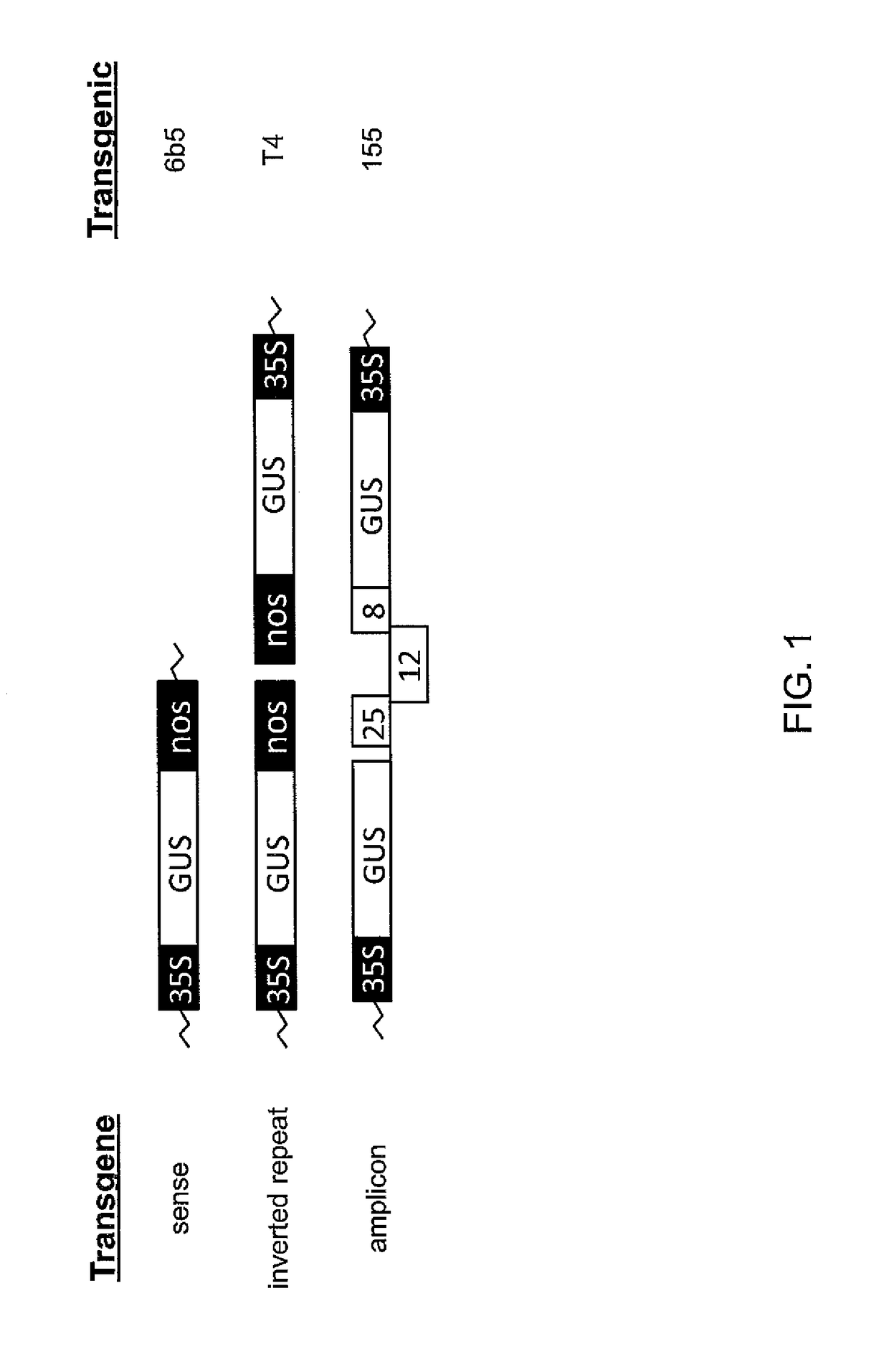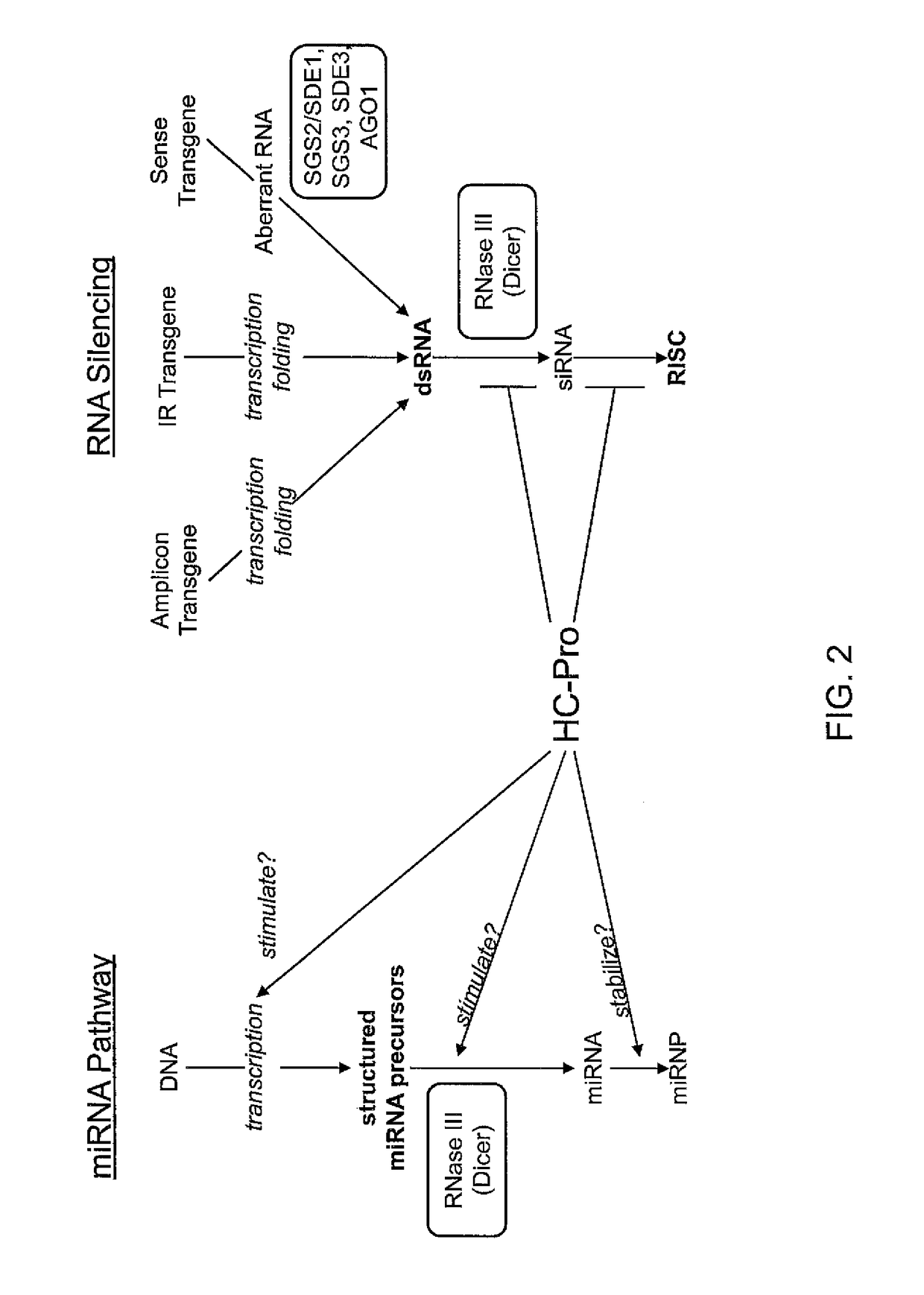Compositions and methods for the modulation of gene expression in plants
a technology of gene expression and composition, applied in the field of composition and methods for modulating gene expression in plants, can solve problems such as mixed efforts, and achieve the effects of enhancing the regulatory capability of mirna, enhancing the effect of gene expression, and altering rna silencing
- Summary
- Abstract
- Description
- Claims
- Application Information
AI Technical Summary
Benefits of technology
Problems solved by technology
Method used
Image
Examples
example 1
HC-Pro Suppression of IR- or Amplicon-Induced RNA Silencing Interferes with the Accumulation of siRNAs and Promotes Accumulation of a Novel Class of Slightly Larger RNAs
[0084]RNA silencing is induced by dsRNA that is cleaved into the siRNAs that mediate sequence-specific RNA degradation. HC-Pro suppression of RNA silencing induced by the b-glucuronidase (GUS) sense transgene eliminates the accumulation of siRNAs (Elmayan and Vaucheret (1996) Plant Journal 9:787-797; Mallory et al. (2001) Plant Cell 13:571-583). To determine if HC-Pro suppression of RNA silencing in IR and amplicon transgenic lines T4 and 155 (Angell and Baulcombe (1997) Embo J 16:3675-3684; Hobbs et al. (1990) Plant Mol Biol 15:851-864) also eliminates siRNA accumulation, small RNAs were analyzed from the offspring of crosses between these lines and either a non-transformed (NT) control plant or an HC-Pro expressing line (line X-27-8; Mallory et al., 2001). The IR transgene in line T4 contains two GUS genes arranged...
example 2
HC-Pro Increases the Level of miRNA Accumulation in Tobacco
[0087]HC-Pro inhibits siRNA accumulation, suggesting that HC-Pro may alter the activity of the Dicer-like RNase III responsible for siRNA production. Because miRNAs are also products of a Dicer-like RNase III in plants (Reinhart et al. (2002) Genes &Development 16:1616-1626), we examined the effect of HC-Pro on miRNA accumulation. Four miRNAs were chosen for these experiments. Each was identified in Arabidopsis, but predicted, on the basis of sequence similarity, to be highly conserved throughout the flowering plants. The expression of all four miRNAs was detected in tobacco supporting the phylogenetic conservation of the miRNAs (Reinhart et al. (2002) Genes &Development 16:1616-1626). Strikingly, we found that BC-Pro increased the accumulation of these miRNAs approximately 5 to 10 fold. No miRNA precursors were detected in HC-Pro-expressing or nonexpressing lines suggesting that they are rapidly processed, degraded or too l...
example 3
Construction and Optimization of Nucleotide Sequences Encoding miRNAs
[0089]Precursors miRNA are designed to target specific messenger RNAs (mRNAs) and alter expression of the protein encoded by that mRNA by the method described hereinbelow or by any other method known in the art. The overall approach is to design an RNA transcript (the miRNA precursor) that is capable of being processed via the miRNA biogenesis pathway to produce an miRNA that is complementary to a particular target mRNA. The miRNA that is processed from this designer miRNA precursor is capable of binding to the targeted mRNA and altering the expression of the protein it encodes. The expression of the targeted protein is assayed to determine if expression of the miRNA precursor results in altered gene expression. There are three steps in implementation of the method: 1) the designer miRNA precursor is constructed and cloned into a binary vector 2) the designer miRNA is expressed in plants or plant tissues that also ...
PUM
| Property | Measurement | Unit |
|---|---|---|
| thermal melting point | aaaaa | aaaaa |
| temperature | aaaaa | aaaaa |
| temperature | aaaaa | aaaaa |
Abstract
Description
Claims
Application Information
 Login to View More
Login to View More - R&D
- Intellectual Property
- Life Sciences
- Materials
- Tech Scout
- Unparalleled Data Quality
- Higher Quality Content
- 60% Fewer Hallucinations
Browse by: Latest US Patents, China's latest patents, Technical Efficacy Thesaurus, Application Domain, Technology Topic, Popular Technical Reports.
© 2025 PatSnap. All rights reserved.Legal|Privacy policy|Modern Slavery Act Transparency Statement|Sitemap|About US| Contact US: help@patsnap.com


